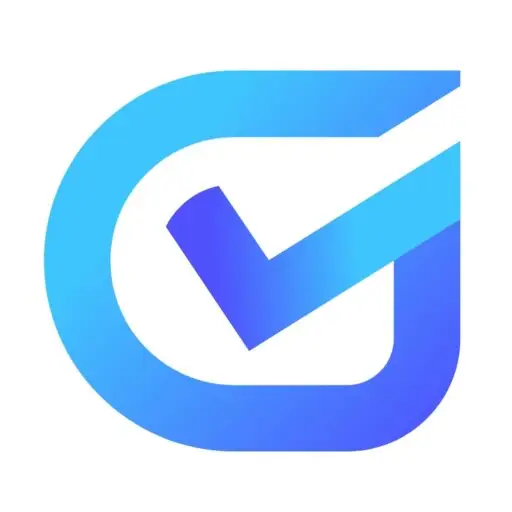California level 2 background checks represent the most comprehensive employment screening available through the California Department of Justice. They require LiveScan fingerprinting and both state and FBI criminal history searches for positions involving vulnerable populations. This guide provides compliance-driven HR professionals and business owners with actionable frameworks to navigate DOJ clearance requirements, streamline LiveScan processes, and maintain regulatory compliance across healthcare, education, and childcare industries.
Key Takeaways
- California level 2 background checks require LiveScan fingerprinting with both DOJ and FBI database searches, typically mandated for positions involving children, elderly, or disabled individuals.
- The California DOJ clearance letter process takes 3-5 business days for state results and 2-4 weeks for complete FBI clearance, with expedited options available for urgent hiring needs.
- Level 2 vs level 1 background check differences include FBI involvement, fingerprint requirements, and depth of criminal history review, with level 2 providing nationwide coverage.
- California background check turnaround time depends on FBI processing volumes, applicant criminal history complexity, and whether digital fingerprint submissions meet quality standards.
- Employers must maintain FCRA compliance by obtaining written consent, providing pre-adverse action notices, and following specific disclosure requirements before making hiring decisions.
- Industry-specific requirements vary significantly, with healthcare facilities needing Health Facility Clearances and childcare providers requiring TrustLine registry completion alongside standard DOJ screening.
- Continuous monitoring programs and periodic re-screening protocols help organizations maintain ongoing compliance with evolving California regulations and licensing board requirements.
Understanding California Level 2 Background Check Requirements
California's tiered background check system distinguishes between basic employment screening and enhanced investigations required for sensitive positions. The California level 2 background screening represents the state's most thorough criminal history evaluation. It is mandated by California Penal Code Section 11105.3 for roles involving vulnerable populations. This comprehensive process combines state and federal databases to provide employers with complete criminal history information necessary for informed hiring decisions.
The California Department of Justice administers these background checks through an integrated system. This system connects local law enforcement, state repositories, and FBI databases. Employers must understand which positions legally require level 2 screening versus those where enhanced checks remain optional. Healthcare facilities, educational institutions, childcare centers, and organizations serving elderly or disabled clients typically fall under mandatory level 2 requirements.
Level 2 background checks fulfill both legal compliance obligations and risk management objectives for organizations working with protected populations. The process verifies identity through biometric fingerprinting while searching comprehensive criminal databases spanning all 50 states and federal jurisdictions. Understanding these requirements helps HR professionals develop compliant screening protocols that balance thorough vetting with efficient hiring timelines.
Level 2 vs Level 1 Background Check: Critical Differences
Scope and Database Coverage
Level 1 background checks search only California state criminal records using name-based queries. These basic screenings access California DOJ databases but exclude federal records and out-of-state criminal history. Most general employment positions utilize level 1 checks when no specific regulatory mandate exists for enhanced screening.
Level 2 background checks expand coverage to include FBI databases through fingerprint-based identification. This California level 2 background check process searches Interstate Identification Index (III) systems connecting all state repositories with federal records. The biometric fingerprint component eliminates name confusion and ensures accurate identity verification across jurisdictions. Organizations hiring for positions involving vulnerable populations gain protection from negligent hiring claims through comprehensive level 2 screening.
Fingerprinting and Processing Methods
Name-based background checks completed at level 1 rely on California databases searching arrest and conviction records matched to provide identification information. Applicants typically provide consent forms with personal details including previous addresses and aliases. Processing occurs through DOJ systems without biometric verification, creating potential accuracy issues when common names or identity theft complicate searches.
LiveScan fingerprinting technology powers level 2 screening through electronic capture and transmission of applicant fingerprints to both California DOJ and FBI databases. Applicants must visit authorized LiveScan service providers where trained technicians capture fingerprints meeting quality standards for automated matching systems. The California background check turnaround time differs substantially between methods, with name-based searches completing within 24-48 hours while fingerprint-based level 2 checks require 3-5 days for state results plus additional weeks for FBI processing.
Legal Requirements by Industry
California law mandates level 2 background checks for specific employment categories where public safety concerns justify enhanced screening. Healthcare positions requiring professional licenses, direct patient care roles, and administrative staff with access to controlled substances typically require DOJ clearance letters. The California Department of Public Health enforces these requirements for hospitals, clinics, nursing homes, and home health agencies.
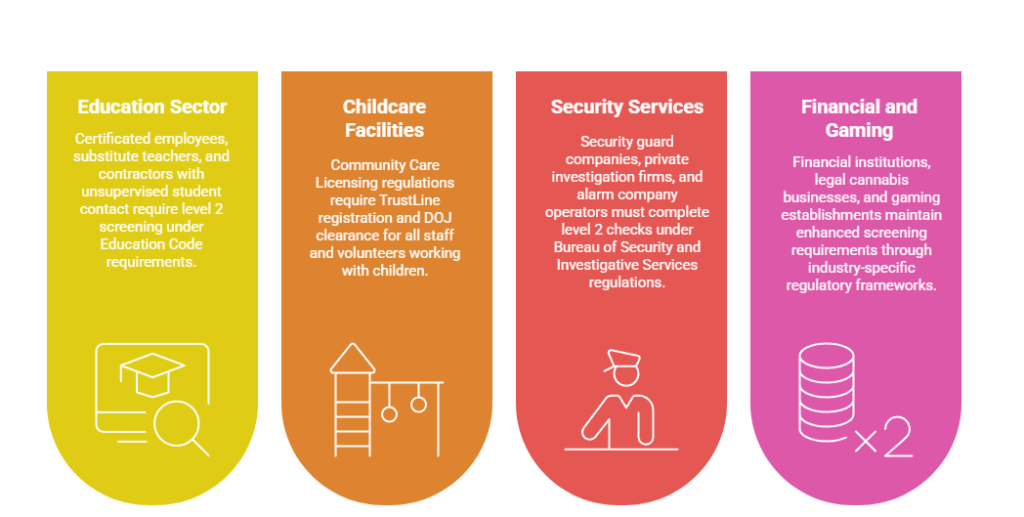
- Education Sector: Certificated employees, substitute teachers, and contractors with unsupervised student contact require level 2 screening under Education Code requirements.
- Childcare Facilities: Community Care Licensing regulations require TrustLine registration and DOJ clearance for all staff and volunteers working with children.
- Security Services: Security guard companies, private investigation firms, and alarm company operators must complete level 2 checks under Bureau of Security and Investigative Services regulations.
- Financial and Gaming: Financial institutions, legal cannabis businesses, and gaming establishments maintain enhanced screening requirements through industry-specific regulatory frameworks.
Understanding your organization's legal obligations prevents compliance violations while establishing defensible hiring practices. Youth sports organizations, summer camps, and after-school programs increasingly adopt level 2 standards even when not legally mandated.
The California DOJ Clearance Letter Process
Obtaining Your Request for Live Scan Service Form
Employers must first determine the appropriate Applicant Type Code (ORI number) corresponding to their industry and licensing requirements before initiating screening. The California DOJ maintains specific ORI codes for healthcare facilities, educational institutions, childcare providers, and other regulated entities. Requesting agencies or licensing boards typically provide Request for Live Scan Service forms pre-populated with correct ORI codes and billing information.
Organizations new to california doj clearance letter requirements should contact their licensing authority or regulatory agency to obtain proper authorization codes and forms. Healthcare facilities reference the California Department of Public Health, while educational institutions coordinate with the California Commission on Teacher Credentialing. Proper form completion prevents processing delays and rejection of fingerprint submissions by DOJ systems.
Completing LiveScan Fingerprinting
Applicants must schedule appointments with authorized LiveScan service providers located throughout California. These include police departments, private fingerprinting businesses, and commercial background check companies. The doj background check cost typically includes two components: DOJ processing fees paid to the state and LiveScan service fees paid to the fingerprinting provider. Applicants should bring government-issued photo identification and completed Request for Live Scan Service forms to appointments.
| LiveScan Provider Type | Average Cost | Typical Wait Time | Additional Services |
| Police Departments | $49-$65 | Walk-in or same-day | Government ID verification |
| Private Fingerprint Services | $55-$79 | Appointment-based | Notary, passport photos |
| Mobile LiveScan Services | $75-$95 | On-site at employer | Group scheduling discounts |
Electronic transmission occurs immediately following successful fingerprint capture, with results typically appearing in DOJ systems within minutes. Organizations should implement tracking systems connecting applicant information with LiveScan transaction numbers to monitor California background check turnaround time and identify processing issues requiring follow-up.
Understanding Processing Timelines and Results
California DOJ processes level 2 background checks through automated systems comparing fingerprints against state criminal databases. Results generate within 3-5 business days for applicants with no criminal history. FBI processing adds 2-4 additional weeks depending on current volumes and whether applicants have prior federal arrests or out-of-state records requiring manual review.
Results arrive through multiple channels depending on submission parameters. These include direct mail to applicants, secure electronic delivery to requesting organizations, or posting to licensing board portals. The California DOJ clearance letter format includes applicant identification, submission details, and either "no record" notifications or summarized criminal history information. Delayed results often stem from fingerprint quality issues, FBI database maintenance periods, or records requiring manual review by DOJ analysts.
Compliance Framework for California Background Check Implementation

FCRA Requirements and Disclosure Obligations
The Fair Credit Reporting Act establishes strict procedures employers must follow when using background checks for employment decisions. Organizations must provide applicants with clear, standalone disclosure documents explaining that background checks will be conducted and may influence hiring decisions. California law adds additional requirements through the Investigative Consumer Reporting Agencies Act (ICRAA), mandating specific language and timing for disclosures.
Employers must obtain written consent from applicants before initiating any background check. The disclosure and consent forms must be separate from employment applications, presented as standalone documents without extraneous information. Pre-adverse action procedures require employers to provide applicants with background check results and Fair Credit Reporting Act summary of rights before making negative employment decisions. Organizations must allow reasonable time periods—typically 5 business days minimum—for applicants to dispute accuracy or provide context for criminal records.
California-Specific Regulatory Considerations
California Fair Chance Act provisions significantly limit how employers may use criminal history in employment decisions. The law prohibits inquiries about convictions before conditional offer stages. The "ban the box" framework delays background check processes until after initial screening and interviews conclude. Employers may only withdraw offers based on criminal history demonstrating direct and adverse relationships with specific job duties.
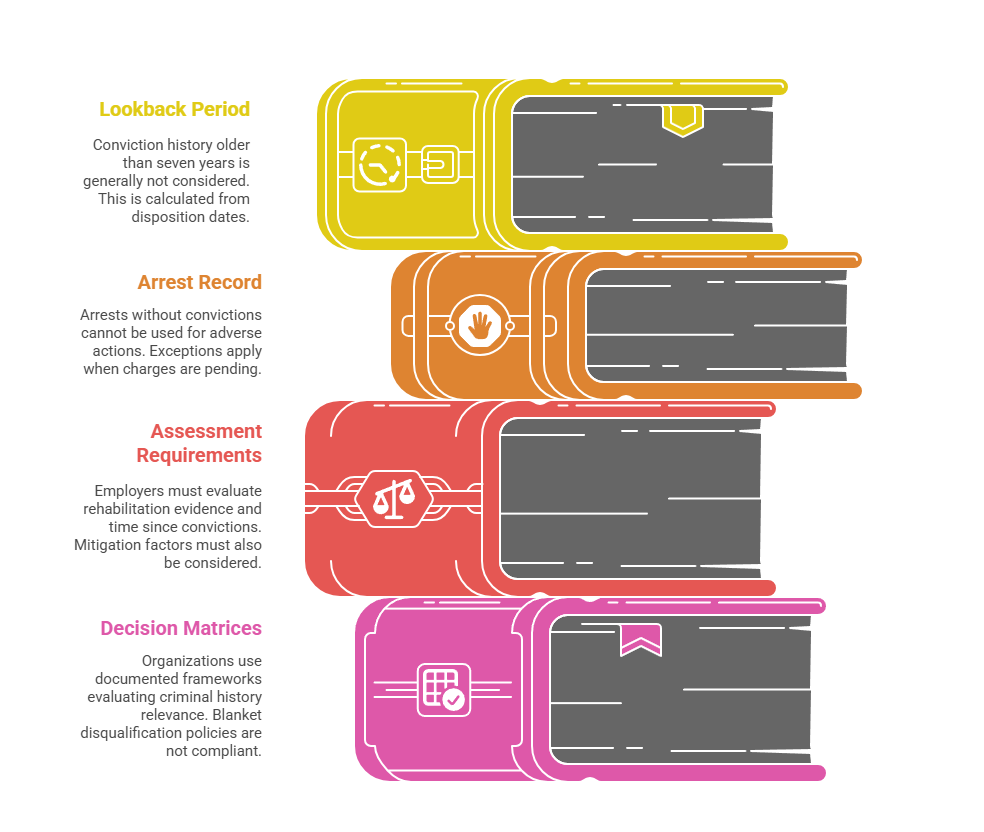
- Seven-Year Lookback Period: Conviction history older than seven years generally cannot be considered under California Civil Code Section 1786.18, calculated from disposition dates with exceptions for positions paying over $125,000 annually.
- Arrest Record Limitations: Arrests without convictions cannot serve as bases for adverse employment actions except when charges remain pending or in limited regulated circumstances.
- Individualized Assessment Requirements: Assembly Bill 1008 mandates employers evaluate rehabilitation evidence, time passage since convictions, and mitigation factors before final determinations.
- Structured Decision Matrices: Compliant organizations implement documented frameworks evaluating criminal history relevance to specific job functions rather than applying blanket disqualification policies.
Organizations must balance public safety obligations with Fair Chance Act protections through carefully designed policies and training programs. Documentation proving individualized assessment processes protects against discrimination claims.
Industry-Specific Licensing Board Requirements
Healthcare facilities must navigate complex regulatory frameworks combining DOJ requirements with professional licensing board standards and Medicare/Medicaid exclusion list checking. The California Department of Public Health mandates criminal record clearances for licensed healthcare practitioners, direct patient care staff, and employees with access to pharmaceuticals or controlled substances. Background checks must be completed before employment begins, with no provisional work allowed during processing periods.
Educational institutions follow California Commission on Teacher Credentialing requirements for certificated staff alongside broader Education Code mandates for all school employees and volunteers. District policies often exceed minimum legal requirements, implementing periodic re-screening protocols every 3-5 years. Childcare providers must complete TrustLine registration through the California Department of Social Services in addition to standard DOJ clearances. This creates parallel screening systems with separate applications and processing timelines.
Cost Analysis and Budget Planning
Standard California level 2 background check expenses include $32 California DOJ processing fees and $17 FBI processing fees. This totals $49 in direct government costs per applicant. These statutory fees apply uniformly across all industries and cannot be negotiated or reduced. Organizations must determine whether applicants or employers bear these costs based on company policy and legal obligations.
LiveScan service provider fees add $17-$60 depending on provider type, location, and service level selected. Private fingerprinting businesses typically charge higher fees than government facilities but offer more flexible scheduling and faster service. Mobile LiveScan providers charging $75-$95 may prove cost-effective for organizations processing multiple applicants simultaneously. Hidden costs include staff time coordinating background check processes, tracking submission status, reviewing results, and maintaining compliant documentation systems.
Volume discounts become available through corporate accounts with LiveScan providers and background check companies offering comprehensive services beyond basic DOJ submissions. Organizations processing 50+ checks annually should negotiate service agreements establishing per-check pricing, guaranteed turnaround times, and dedicated account management. These partnerships streamline administrative burdens while reducing per-check costs through economies of scale.
Optimizing Turnaround Time and Processing Efficiency
Factors Affecting Processing Speed
FBI database volumes fluctuate seasonally, with peak processing times occurring during summer months when educational institutions screen staff before the academic year starts. Organizations hiring during high-volume periods should expect extended California background check turnaround time potentially reaching 6-8 weeks for complete results. Planning recruitment timelines around these patterns prevents hiring delays and reduces pressure to make provisional employment decisions.
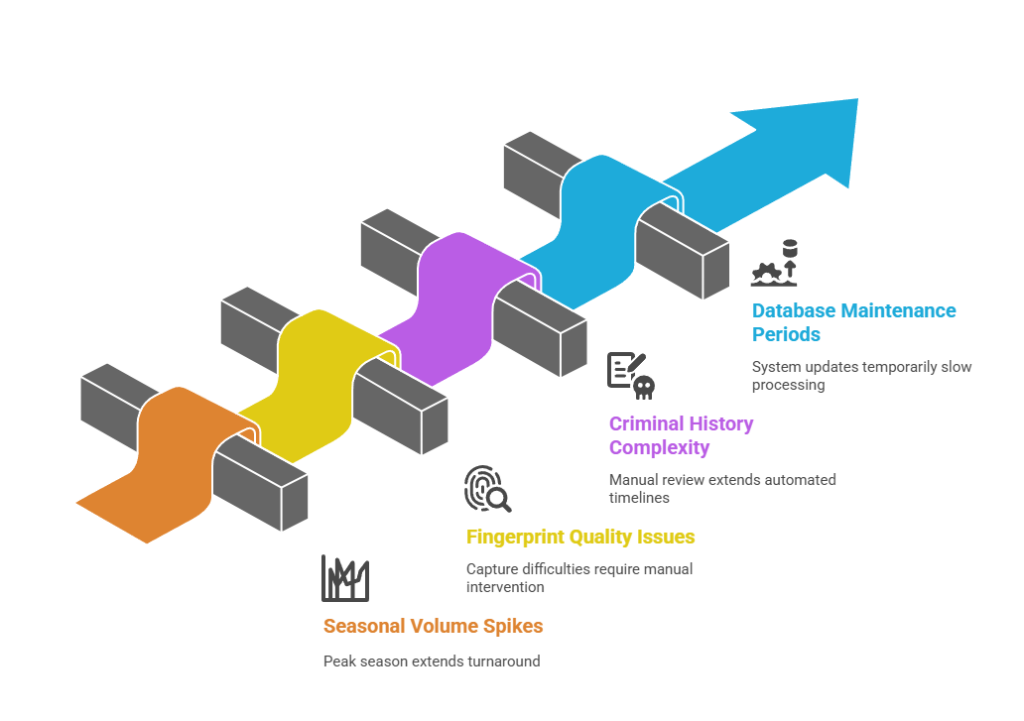
- Seasonal Volume Fluctuations: Summer months see peak FBI processing loads from educational hiring, extending turnaround times from typical 2-4 weeks to potentially 6-8 weeks for complete results.
- Fingerprint Quality Issues: Dry skin, worn fingerprints from manual labor, or finger injuries create electronic capture difficulties requiring moisturizers or alternative techniques from LiveScan technicians.
- Criminal History Complexity: Records requiring verification across multiple jurisdictions or matching names with federal investigation histories trigger manual review processes extending standard automated timelines.
- Database Maintenance Periods: Scheduled FBI and DOJ system updates temporarily slow processing, particularly affecting submissions during end-of-month maintenance windows.
Applicants should disclose known criminal records proactively, allowing employers to anticipate extended processing periods and adjust hiring timelines accordingly. This transparency prevents surprises while demonstrating candidate honesty.
Strategies for Expedited Processing
Rolling recruitment models allow organizations to continuously accept applications and initiate background checks rather than batch processing. This approach distributes workload across the year and avoids seasonal bottlenecks. It works particularly well for industries with consistent turnover like healthcare facilities and childcare centers. Maintaining candidate pipelines with pre-cleared applicants reduces time-to-fill metrics and operational disruptions from unexpected vacancies.
Provisional employment policies allow candidates to begin work before complete california doj clearance letter arrival, subject to immediate termination if disqualifying information appears. This strategy proves effective in non-regulated industries where legal prohibitions against provisional work don't exist. Applicants can request "Record Review" appointments at California DOJ offices to identify and correct inaccurate criminal history information before employment background checks. The review process typically takes 30-60 days but eliminates delays during employment screening.
Maintaining Ongoing Compliance and Re-Screening Protocols
California regulations increasingly require periodic re-screening for employees in sensitive positions rather than one-time clearances at hiring. Healthcare facilities typically implement 2-4 year re-screening cycles aligned with license renewal periods or accreditation standards. Educational institutions may require background checks every 5 years for continuing employees, though requirements vary by district and position type.
Continuous monitoring services offered by background check companies provide real-time notifications when employees face new arrests or convictions after initial clearance. These systems search daily arrest records and court filings, alerting employers to criminal activity potentially impacting employment eligibility. California law requires careful consideration of how continuous monitoring integrates with Fair Chance Act provisions and employee privacy protections. Organizations must obtain proper consent and provide clear disclosures about ongoing monitoring practices.
Triggering events beyond scheduled re-screening cycles may necessitate additional background checks. These include professional license disciplinary actions, workplace incidents suggesting criminal activity, or employee transfers to positions with different background check requirements. Record retention requirements under California law mandate organizations maintain background check records for minimum periods varying by industry, typically 2-4 years after employment termination. Digital document management systems with encryption and access controls provide security while facilitating audit responses and regulatory inspections.
Troubleshooting Common Background Check Challenges
Addressing Incomplete or Delayed Results
Missing FBI results represent the most common delay pattern. This occurs when federal processing extends beyond typical timeframes due to volume surges or complex record verification. Employers should contact background check companies or directly query DOJ systems after four weeks without FBI results to verify submission status. California DOJ results typically arrive first, allowing preliminary employment decisions while FBI processing completes for lower-risk positions.
Applicants may need to complete additional fingerprinting if initial submissions fail quality standards or if technical issues prevent successful database searching. The LiveScan system immediately notifies technicians about rejected prints, but subsequent problems occasionally emerge during DOJ processing. "Challenge process" procedures allow applicants to dispute inaccurate criminal records appearing on background checks, requiring employers to pause adverse action timelines while investigations proceed.
Interpreting Complex Criminal History Results
California DOJ clearance letters may contain cryptic codes, incomplete disposition information, or references to sealed or expunged records potentially causing confusion during result interpretation. Organizations should develop partnerships with legal counsel or specialized background check companies providing expert analysis of complicated criminal histories. Investment in professional interpretation prevents improper adverse actions while ensuring consistent application of company policies.
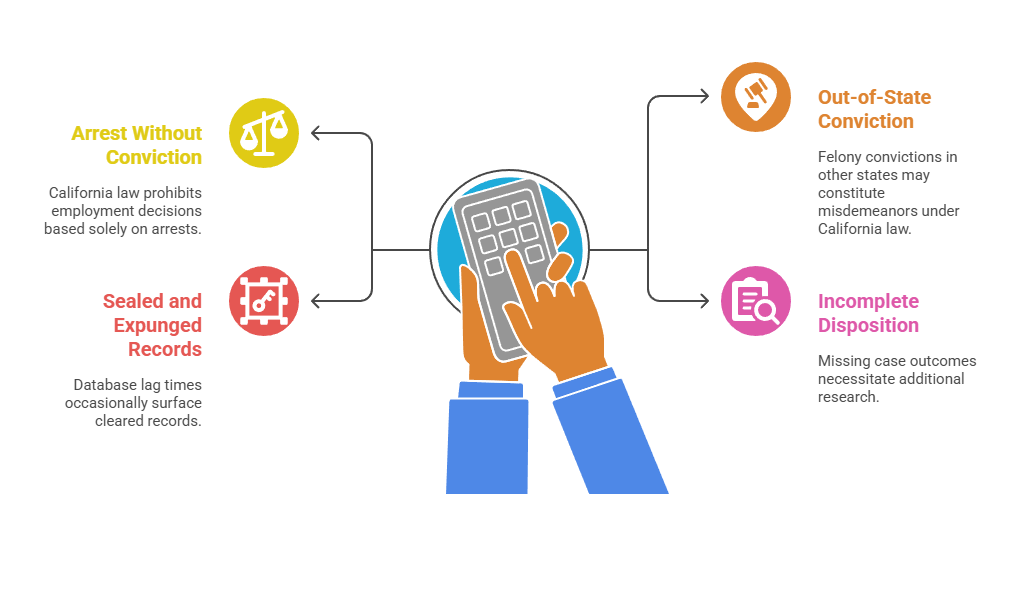
- Arrest Without Conviction Dispositions: California law prohibits employment decisions based solely on arrests, requiring investigation of whether charges remain pending, were dismissed, or resulted in unreported convictions.
- Out-of-State Conviction Equivalency: Felony convictions in other states may constitute misdemeanors under California law, affecting relevance calculations under Fair Chance Act provisions requiring proper legal analysis.
- Sealed and Expunged Record References: Database lag times occasionally surface cleared records, requiring candidates to provide court documentation proving expungement or record sealing.
- Incomplete Disposition Information: Missing case outcomes necessitate additional research through court records or candidate-provided documentation to determine actual conviction status.
Organizations must avoid making assumptions about criminal records without proper legal analysis and candidate opportunity to provide context. Consistent application of interpretation protocols across all applicants protects against disparate impact discrimination claims.
Conclusion
Navigating california level 2 background check requirements demands comprehensive understanding of regulatory frameworks, practical implementation strategies, and ongoing compliance obligations. Organizations serving vulnerable populations must prioritize thorough screening while maintaining efficient hiring processes through strategic planning and technology integration. The complexity of California's layered requirements—combining DOJ mandates, FBI involvement, industry-specific regulations, and Fair Chance Act provisions—necessitates dedicated compliance resources and expert partnerships. By implementing the frameworks outlined in this guide, HR professionals and business owners can transform background check obligations from administrative burdens into competitive advantages, building trustworthy workforces while maintaining operational efficiency throughout 2025 and beyond.
Frequently Asked Questions
What is the difference between Level 1 and Level 2 background checks in California?
Level 1 background checks search only California state criminal records using name-based queries, while California level 2 background screening includes LiveScan fingerprinting with both California DOJ and FBI database searches. The enhanced Level 2 checks provide nationwide criminal history coverage including federal offenses, whereas Level 1 checks capture only in-state records. Positions involving children, elderly, disabled individuals, or other vulnerable populations legally require Level 2 screening. For general employment positions without specific regulatory requirements, Level 1 suffices.
How long does a California DOJ clearance letter take to process?
California DOJ processes level 2 background checks within 3-5 business days for state results when applicants have no criminal history. FBI processing adds 2-4 weeks to the total California background check turnaround time, though complex cases requiring manual record verification may extend to 6-8 weeks. Processing speed varies based on seasonal volume fluctuations, fingerprint quality issues, and whether applicants have prior arrests requiring multi-jurisdictional record confirmation. Organizations should plan hiring timelines accounting for 4-6 week total processing periods.
How much does a DOJ background check cost in California?
The doj background check cost includes $32 California DOJ processing fee and $17 FBI processing fee, totaling $49 in government charges. LiveScan fingerprinting service fees add $17-$60 depending on provider type and location, bringing total applicant costs to $66-$109. Mobile LiveScan services charging $75-$95 may prove cost-effective for organizations processing multiple applicants simultaneously. Employers should clarify whether the organization or applicant bears these costs based on industry requirements.
Can employers conduct background checks before making job offers in California?
California Fair Chance Act prohibits employers from inquiring about criminal history or conducting background checks until after making conditional employment offers, with exceptions for specific positions where law enforcement agencies or criminal justice requirements mandate earlier screening. Organizations must complete initial candidate evaluation, interviews, and preliminary selection processes before initiating California level 2 background check procedures. Once conditional offers are extended, employers may conduct comprehensive background screening but must follow individualized assessment protocols and pre-adverse action procedures.
What criminal records appear on California Level 2 background checks?
Level 2 background checks reveal arrests and convictions from California state databases and FBI records covering all 50 states and federal jurisdictions. Results include felony and misdemeanor convictions, pending charges, arrest records, and sex offender registry information. California law limits consideration to convictions within seven years for most positions, excluding arrests without convictions except when charges remain pending. Sealed, expunged, and dismissed records should not appear but occasionally surface due to database lag times.
Do healthcare workers need Level 2 background checks in California?
Healthcare facilities must conduct California level 2 background screening for licensed practitioners, direct patient care staff, and employees with access to pharmaceuticals or controlled substances under California Department of Public Health regulations. Hospitals, clinics, nursing homes, home health agencies, and other licensed healthcare operations must obtain DOJ clearance letters before employment begins, with no provisional work allowed during processing. Healthcare organizations must also check the Office of Inspector General and System for Award Management exclusion lists to ensure Medicare/Medicaid eligibility.
How often do California employers need to re-screen employees?
Re-screening frequency varies by industry and specific regulatory requirements, with healthcare facilities typically implementing 2-4 year cycles and educational institutions requiring background checks every 5 years for continuing employees. Childcare providers may need updated clearances upon license renewal, while some industries lack mandatory re-screening requirements. Organizations should establish clear policies defining re-screening frequencies based on position sensitivity, licensing board requirements, and risk management objectives. Continuous monitoring services provide real-time notification of new criminal activity between scheduled re-screening cycles.
What happens if a background check reveals criminal history?
California Fair Chance Act requires employers to conduct individualized assessments evaluating criminal history relevance to specific job duties before making adverse employment decisions. Organizations must consider offense nature, time elapsed since conviction, rehabilitation evidence, and position requirements through structured evaluation frameworks. Employers must provide pre-adverse action notices including background check results and allow a minimum of 5 business days for applicants to dispute accuracy or provide context. Final adverse action notices must explain decisions and inform applicants of dispute rights under FCRA.
Additional Resources
- California Department of Justice - Criminal Record Review Information
https://oag.ca.gov/fingerprints/record-review - California Fair Chance Act - Employment Development Department Guide
https://www.edd.ca.gov/jobs_and_training/fair_chance_act.htm - Federal Trade Commission - Background Checks: What Employers Need to Know
https://www.ftc.gov/business-guidance/resources/background-checks-what-employers-need-know - California Department of Social Services - TrustLine Registry Information
https://www.trustline.org/ - FBI - Identity History Summary Checks
https://www.fbi.gov/how-we-can-help-you/need-an-identity-history-summary-background-check
Still have questions?
Get in touch with our team today for a personalized demo and discover how our tailored volume pricing and packages can drive results for your business!
How useful was this page?*
Note: your comments are anonymous. We use them to improve the website. Do not include any personal details.
Visit our FCRA Compliance Tool or leave a message here if you need a response.
From the blog Explore the GCheck Content Hub

How to Perform OIG Exclusion Screening: Step-by-Step Guide
20 Nov, 2025 • 24 min read
Illinois Tenant Screening Laws: Chicago & Cook County Compliance Guide for Landlords
19 Nov, 2025 • 20 min read
FCRA Penalties for Small Businesses: 2025 Compliance Costs & Violation Fines
12 Nov, 2025 • 20 min readThe information provided in this article is for general informational and educational purposes only and should not be construed as legal advice or a substitute for consultation with qualified legal counsel. While we strive to ensure accuracy, employment screening laws and regulations—including but not limited to the Fair Credit Reporting Act (FCRA), Equal Employment Opportunity Commission (EEOC) guidelines, state and local ban-the-box laws, industry-specific requirements, and other applicable federal, state, and local statutes—are subject to frequent changes, varying interpretations, and jurisdiction-specific applications that may affect their implementation in your organization. Employers and screening decision-makers are solely responsible for ensuring their background check policies, procedures, and practices comply with all applicable laws and regulations relevant to their specific industry, location, and circumstances. We strongly recommend consulting with qualified employment law attorneys and compliance professionals before making hiring, tenant screening, or other decisions based on background check information.

